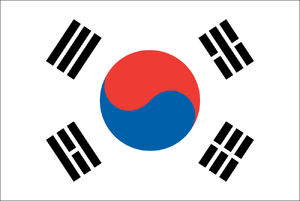
The Flag of The Republic of Korea
The Republic of Goryeo, also referred to as Korea, is a sovereign state in East Asia, constituting the Korean Peninsula. The name Korea is derived from the ancient Kingdom of Goguryeo, also known as Koryŏ. It shares land borders with the Dominion of Manchukuo to the north, and oversea borders with Japan. Roughly half of the country's 51 million people reside in the Seoul Capital Area, the second largest in the world with over 25 million residents.
History[]
Despite the initial plan of a reunified Goryeo in the 1943 Cairo Declaration, escalating Cold War antagonism between the Soviet Union and the United States eventually led to the establishment of separate governments, each with its own ideology, leading to the division of Korea into two political entities in 1948: North Goryeo and South Goryeo.
This division stood for approximately 75 years, until the regime of the People's Republic of Goryeo was overthrown by the Muteki Daitai PMC in 2028 during the Daitai-Goryeon Conflict, which saw the execution of the North Goryeon President and several of his relatives. As a measure of the defeat of North Goryeo, the former Communist nation surrendered to the South, and was annexed.
In 2029, Japan and Goryeo signed the Mutually Assured Protection Act of 2029, after it was revealed that both the previous Japanese Prime Minister and Goryeon President had been put into office by the CIA. This treaty saw the two nations withdraw from NATO, and form their own alliance, with the Muteki Daitai PMC, known as the Pacific-Asia Defense League. PADL would later be reorganized into the Coalition Union when the Persian Confederacy signed onto MAPA.
In the 2030s, the Republic of Goryeo was harassed by the Korean Juche Party, which was backed by the American Central Intelligence Agency. The Korean Juche Party attempted a Coup D'Etat, but was defeated by the Republic of Goryeo Army. This led to the Republic of Goryeo further isolating itself from America and its allies.
Military[]
The Republic of Goryeo Armed Forces is one of the largest militaries in the world, behind the Arabian Federation, Dominion of Manchukuo, Greater Empire of Japan, and Muteki Daitai PMC. The Republic of Goryeo Armed Forces' mission is to defend Goryeo and her allies, from threats internal and external. As well, the Armed Forces are responsible for peacekeeping operations on behalf of the United Nations.
Culture[]
The traditional culture of Goryeo refers to the cultural heritage of the Korean Peninsula. Before Joseon Dynasty, the practice of Korean shamanism was deeply rooted in the Goryeon culture.
As with music, there is a distinction between court dance and folk dance. Common court dances are jeongjaemu (정재무) performed at banquets, and ilmu (일무), performed at Goryeon Confucian rituals. Jeongjaemu is divided into native dances (향악정재, hyangak jeongjae) and forms imported from Central Asia (당악정재, dangak jeongjae). Ilmu are divided into civil dance (문무, munmu) and military dance (무무, mumu).
Language[]
Korean (한국어/조선말) is the official language of both the Republic of Goryeo, as well as one of the two official languages in Manchukuo's Yanbian Korean Autonomous Prefecture. About 80 million people speak Korean worldwide. For over a millennium, Goryeons wrote with adapted Chinese characters called hanja, complemented by phonetic systems like hyangchal, gugyeol, and idu. In the 15th century, Sejong the Great commissioned a national writing system called Hangul, but it only came into widespread use in the 20th century, because of the yangban aristocracy's preference for hanja.